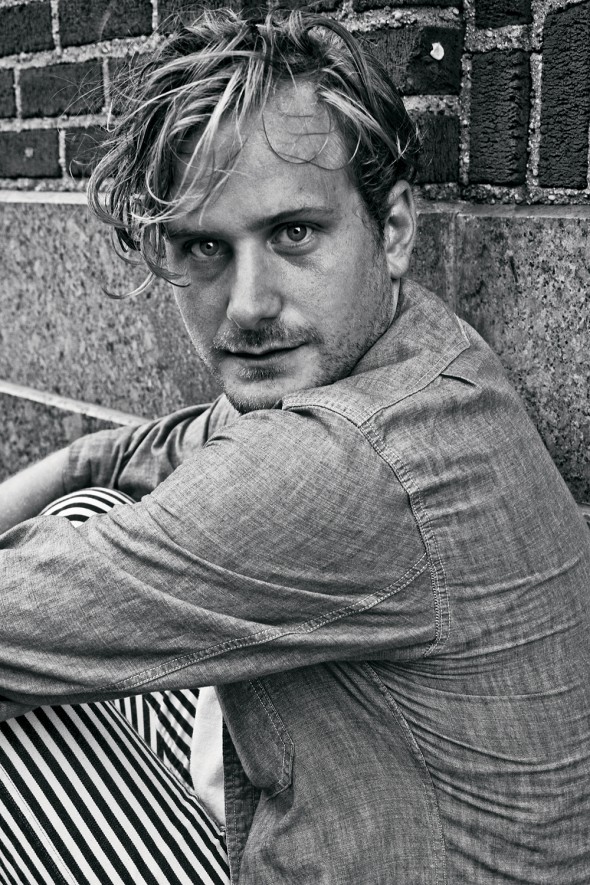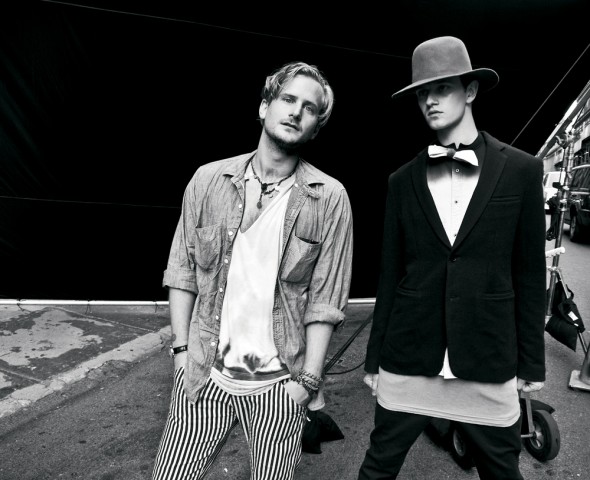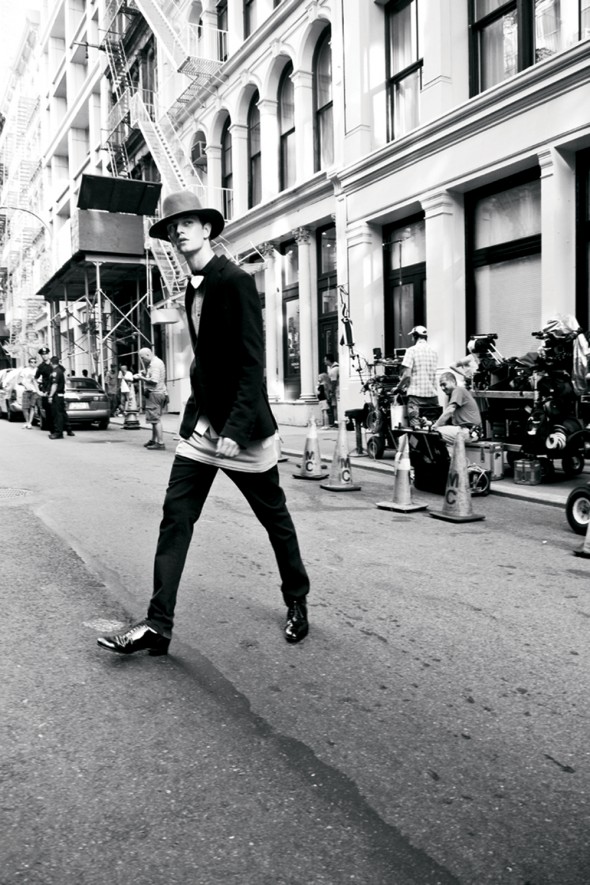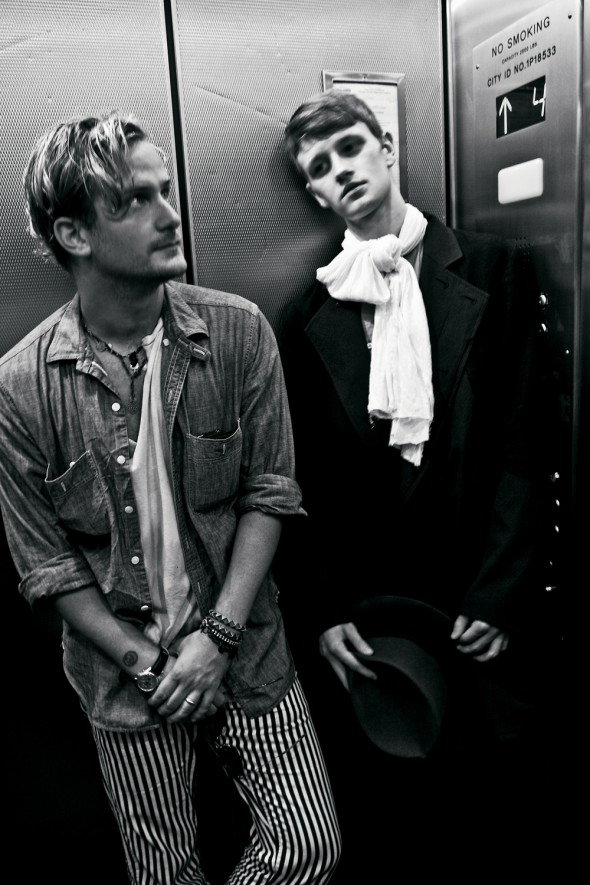
Robert Geller sat next to his older sister on a flight from Germany, en route to London Fashion Week. It was 1989. He was 13-years-old, The Cure was in his Walkman, and he had no idea what he was about to experience. During the trip he saw a few runway shows and visited Yohji Yamamoto and Jean Paul Gaultier boutiques. As he looked out the window on the way back home, above the clouds over Europe, the world seemed different, as if something had changed. And with that, he was addicted.
“There was just something electric about that experience,” he says. “There was an excitement I felt for the first time in my life. It was like walking into a beautiful world, and when I first experienced it…well, it was really intense. I was given the chance to see something so amazing and beautiful and it left me with this impulse, this feeling that is difficult to des-cribe. All I knew was that I wanted to be closer to it.”
Twenty years later, this modern daydreamer is redefining the possibilities of fashion with his own runway shows with a distinguished style and evocative aesthetic. Speaking over the phone from his studio in New York, Geller explains how his desire to learn about fashion might have come even before his first trip to London Fashion Week. “My father was a fashion photographer in Hamburg and I spent a lot of time in his studio. Also, my stepmother owned a really cool vin-tage store. So, I guess that upbringing might have sparked the beginning of my interest in fashion.” He says, “I started at Rhode Island School of Design (RISD) with the intention of becoming a fashion photographer. During my first year, I started developing illustration skills which gave me the confidence to actually study fashion.”

After Geller graduated from RISD, he worked for Marc Jacobs (where he met his wife) and then joined Cloak, a short-lived collection that achieved legendary status in an unprecedented amount of time. The company was key in the evolution of American menswear, just as the ’90s influence of Ford and Lang started to waver in the early ’00s. The experience put Geller on the map and people in the industry began to take notice. The five collections that he developed with Alexandre Plokhov foreshadowed hints of his future direction with his signature silhouette: traditional layers that give a sense of complex textures and mood, with nods to wandering gypsies carrying an air of Bohemia. He left in ’04 before the company folded in ’07.
With Cloak behind him, Geller started the womenswear collection Herald, and then launched Robert Geller in Fall ’07. Starting as a tightly edited capsule, Robert Geller grew quickly after retail support from the likes of Odin New York and Blackbird in Seattle. A Joseph Beuys’s influenced collection, Beuys Don’t Cry delivered yet another breakthrough and in Spring ’08 he brought in bright colors and showed a fit that had graduated from the signature Cloak aesthetic.
While the Spring collection paid homage to the LA skate scene of the early ’90s, his use of dark and romantic themes seemed to be right beneath the surface—an aesthetic that re-appears quite frequently. However, he objects to blanket classifications of dark or moody insisting, “I am personally quite joyful and easygoing. However, my creative side and aesthetic direction are often drawn to darkness. I do love color though, my favorite ones just happen to be darker.”

Geller indeed has a way with dark, mysterious and obliquely romantic style. He says, “For me, romance is a part of the creative process and a part of the aesthetic that I like. When I think of romance in everyday life I often think about music. I consider The Cure to be a romantic band whose songs are dark and moody but often punctuated with moments of joy only to be followed by heartache. The songs reflect love’s power, which is something I try to capture in my own work. I strive to set different moods in my collection and romance is certainly an important element. The man that I try to be loves romance and loves love.”
Regarding designers who have informed his approach he says, “My favorites have always been the Japanese and Belgian designers. My absolute favorite is Ann Demeulemeester. I love her aesthetic and the way she has managed to create such a successful business while remaining true to her point of view.”
Critics of Geller might wonder how his dramatic, runway visions translate onto store racks, but it’s a small price to pay for standing out from the menswear crowd. In response to this, Geller says, “I do offer a whole wardrobe to my customer, but I don’t really expect them to walk around in head-to-toe Robert Geller. What I show on the runway is my own vision and when customers buy pieces and mix and match them with other designers they are creating their own vision which I think is great.”
Mainly working with factories in Japan, Geller is able to execute an extremely high quality level. And while there are key tailored pieces and cutaway jackets, the structure is surprisingly relaxed. Only after the accessories come into play, does the stylized vision really shine through. Overall, he offers hats (with Worth & Worth), shoes, jewelry (with Chie Nakai and Hiroshi Kure of Driftwood), knits, scarves, glasses, sportswear, tailored garments, select formalwear, and a new premium, a T-shirt line called Seconds.

Without those details, the main ethics are for quality and flexibility. Unlike his highly tailored competitors, Geller’s garments do include throw-around basics and suitcase packables. The care, upkeep, colors and fabrics all play to a timeless wearability.
Recently, as part of the prize for being named second annual GQ Best New Menswear Designer in America, Geller designed an 11 piece capsule collection of denim shirts, jeans, and jackets for Levi’s. The archive-inspired collection is already one of the most celebrated collaborations of the season, and a must-have for anyone who appreciates denim.
Yet, even with the acclaim and successes, Geller clearly prefers a position outside the mainstream, claiming, “I imagine my client is someone who is interested in fashion and creativity. As I am not so well known, people need to discover my brand, which means my client also has a sense of curiosity and likes to find things out on his own. He is probably a guy that wants to look strong but not in the traditional machismo sense.”
For S/S ’10, the still developing plan is for a light and positive direction, with a whimsy inspired by Michael Sowa’s paintings. As the conversation drew to an end, and with New York Fashion Week just days away, Geller paused to remember his first visit to Fashion Week in London and the moment when his eyes were first drawn to fashion as a teenager. “I still feel the excitement of that moment. I love to do fashion shows. There is that moment of electricity and every time the music starts and the models walk out it’s exciting. It is more important than showing every detail in the collection. You have these few minutes for your show and you need to just blow people away. That is want I want more than anything else.”
– Michael Cohen & Patrick Knowles
Photography Mike Kobal
Model: Nathan Larson, Fusion Model Management, NYC.
Styling & Grooming: Jordy Poon, NYC

